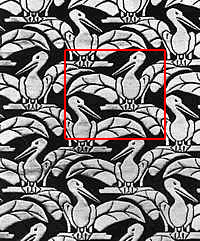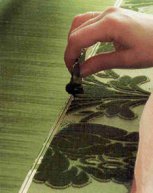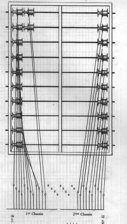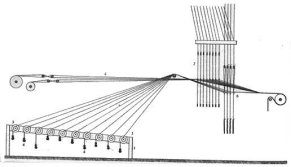- Home
- Resurrection ▾
-
Learn ▾
- Free library
- Glossary
- Documents
- Initiation
-
Shaped fabrics
- Introduction
- Popularization
- Definitions
- Le métier de façonné
- Principes du façonné
- Mécaniques de façonné
- Le jeu des crochets
- Les cartons
- Chaîne des cartons
- Mécanique 104 en détail
- Pour en finir
- Montage façonné
- Empoutage 1/3
- Empoutage 2/3
- Empoutage 3/3
- Punching, hanging and dip
- Autres façonnés
- Façonnés et Islam
-
Cours de tissage 1912
- Bâti d'un métier
- Le rouleau arrière
- Les bascules
- Formation du pas
- Position de organes
- Mécanique 104 Jacquard
- Fonctionnement 104
- Lisage des cartons
- Le battant du métier
- Le régulateur
- Réduction et régulateur
- Mise au métier d'une chaîne
- Mise en route du métier
- Navettes à soie
- Battage
- Ourdissage mécanique
- Préparation chaînes et trames
- Equipment ▾
- Chronicles ▾
- Fabrics ▾
- Techniques ▾
- Culture ▾
- Language ▾

Chiselled VelvetAgnès Alauzet
Chiselled Velvet
Agnès Alauzet
Chiselled Velvet
Agnès Alauzet


On the stroke of the iron we read the two colors, on the coup de fer cut we read just the carmine. It is by this means that one will obtain the superposition of the 2 irons ...
smooth8 hems of 834 meshes or 6672 meshes
Reduction15 irons to cm, 15 irons cut to cm
If our drawing is square (height of 5.33 cm), we will have 5.33 cm x 15 irons x 2 cartons = 160 cartons

(Long entanglement: 1 coil = 1 coil wire or 800 coils)
Work order
1st shot, bottom: satin by the heddles, small mechanical2nd shot, bottom: satin by the heddles, small mechanical3rd stroke, bottom: satin by the heddles, small mechanics, tying hair by the rods, small mechanics4th shot, background: satin by the heddles, small mechanical5th blow, curly iron: the hems fold mass, small mechanical, the hair raises according to the map, mechanical drawing6th blow, iron cut: the healds fold mass, small mechanics, the hair raises according to the map, mechanical drawing
Note to readers
A shot of map =1st cardboard: curled iron, read carmine and yellow2nd cardboard: cut iron, read only carmine
80 threads x 10 paths = 800 threads5.33 cm x 10 paths = 53.33 cm
Pile chain: 800 threads organsin cooked 2 bts 20/22 deniersChain piece: 800 x 8 = 6400 threads organsin cooked 3 bts 20/22 deniers
Arrangement of a velvet carved in 56 cm on a comb of 14.77 teeth / cm, 40 DP
Comber10 paths with tip of 80 ropes, chewed followed on 4 high, tip on the back.
snaring80 hooks, heddles, rods and regulator on a 104 Jacquard
Remettage2 teeth with 2 threads for cordeline, handed taffeta on the satin strapsIe 1 thread on odd smooth, 1 thread on smooth pair.
15 teeth with 8 double wires delivered on 8 beads for satin cord800 teeth to 9 wires by:4 satin yarns handed over 8 beads1 hair wire delivered over 800 links4 satin yarns handed over 8 beads
15 teeth with 8 double wires delivered on 8 beads for satin cord2 teeth with 2 threads for cordeline, handed taffeta on the satin straps
That is 834 teeth in 56 cm
1080 threads5,33 cm
980 threads5,33 cm
880 threads5,33 cm
780 threads5,33 cm
680 threads5,33 cm
580 threads5,33 cm
480 threads5,33 cm
380 threads5,33 cm
280 threads5,33 cm
180 threads5,33 cm








































5 cm x 15 hairs / cm = 75 yarns at the drawing ratio800 yarn bristles / 75 yarn ratio = 10.66 paths rounded to 10 pathsIe 800 wires / 10 paths = 80 wires to the path80/15 = 5.33 cm wide drawing


The hair chain, after having produced these different effects atThe location of the fabric is tied backwards, massing every 4 strokes.
The pile chain is disposed on a body of links all rope passed over rods which will be actuated by the mechanism 104. It is through these rods that the mass will be raisedThe bristles on the binding.
The part chain is put back on 8 beams (frames) placed behind the body of links of the hair (rear side of the loom). The body of hair links is therefore placed near the comb, which will allow aBetter release of the hairy yarns during their evolution (the hair yarns are slightly stretched). The satin flooring is of course on top (because of the velvet), in the 8 satin satin beams will work flap, which avoids to lift 7 threads (heavier) and allows a better clearance between the hair yarn and the piece wires. The 8 satin beams (frames) are ordered by the 104.
Layout:It is easy to understand that since the part warp (satin backing) is put back on the healds (frames), the satin threads (and their wefts) are not represented in the drawing.
The drawing on the layout paper is painted in two colors: one for the velvet cut effects (carmine), and the other for the effects of curly velvet (yellow).
Paper reduction: 8 in 8 or 10 in 10, free stop.
We will execute a chiseled velvet upholstery in 54 cm of width (traditional width that one finds subsequently in the wallpapers).
Pile chain: 15 threads / cm x 54 cm = 810 threads hair, rounded to 800Ie 800/15 = 53.33 cm in width.
We would like a drawing 5 cm wide
NB: The hair is cut higher than the curly hair. This differenceIs not obtained by the use of irons of different heightsOne would suppose, but by the superposition of the two ironsShows the profile above
Curly velvet effect 4 shots under the ironUnder these velvet effects, the satin continues in the background.
Effect velvet cut 4 shots under the iron




The velvet is obtained by weaving two kinds of irons:
Round irons for curly velvet loops (curls) and cut irons for cut velvet (hair). A cutting planer is used to cut the hair and make the clumps and remove the round irons to make the buckles.
Depth study
Velvet engraved a body mounted to the rope and on rods.Proportion of 8 threads pieces for 1 pile yarnSatin bottom of 8 by the piece chain and 1 silk weft (1 lat = 1 single shuttle)

Starting from the reels, all the wires are guided on a glass bar called a hair stick and then directed towards the links.
The bottom is in satin of 8.
The business will include:
1 roll satin1 roll of wire binding1 coil of 800 coils

The spools rotate freely on pins. The tension of the wires is obtained on each coil (which has a groove on one side) by small lead counterweights called bales, suspended from a cord secured in the groove of the coil.


Chased Velvet
The chiseled velvet is a shaped velvet composed of curly velvet (curls) and cut velvet (hair). The two kinds of velvet are of different heights, the cut velvet being higher than the curly velvet.

Little reminder :
Armor fabric: Any non-figurative geometric drawing fabric, the threads of which are controlled by frames. The more frames, the more complex the geometric pattern can be. We use 2 frames (plain weave or taffeta) to 36 frames maximum.
Fabric: To execute a figurative drawing (bouquet of flowers, horse at gallop), frames are more usable. The figurative character of the drawing imposes to be able to lift on demand each thread independently. It is therefore necessary to use a shaped mechanism having a large number of hooks. Parallels are used in parallel to execute the plain background of the fabric (taffeta, satin ...).
In plain velvet, all the hair yarns rise at the same time, whereas in the shaped velvet the hair yarns rise in a variable and independent way, according to the needs of the pattern. However, since the coat is very important (7 meters of hair for 1 meter of fabric), it is impossible to warp this chain on a roller.
Each pile yarn is then placed on a small coil called a velvet coil and these coils are placed on a creel formed by an inclined frame mounted on 4 feet resting on the ground.